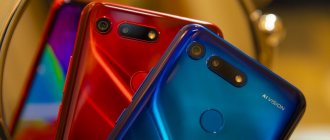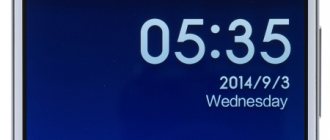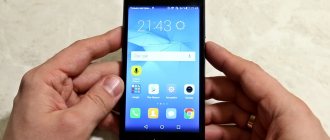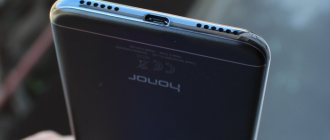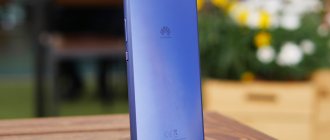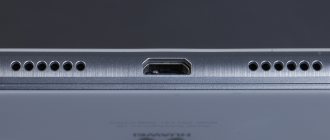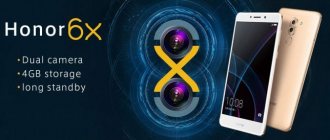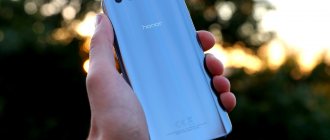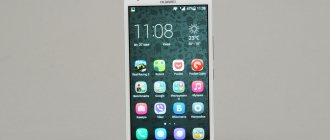15:15 2018-07-31 / Ivan Kushch / Test reviews of equipment
This summer, Huawei announced the release in Russia of a new smartphone, Honor 7C Pro, with a 6-inch widescreen screen, a powerful Qualcomm Snapdragon 450 chip, 3 GB of RAM, a dual camera and an affordable price. In many ways, this was a response to other Chinese brands that produce a huge number of devices in the 8,000 – 10,000 ruble segment. As soon as Honor 7C Pro went on sale, the Yamobi.Ru Internet project conducted detailed testing of it.
Huawei smartphones costing 18,000 - 25,000 rubles already occupy the top of the ratings in terms of popularity among users. The company decided to strengthen its position in the class of budget devices, where devices from Xiaomi rule the roost. According to the developer, the new Honor 7C Pro should become a worthy competitor to such models as Xiaomi Redmi Note 5 and Xiaomi Redmi 5 Plus.
The new product boasts a large 5.99-inch screen with an 18:9 aspect ratio and a “frameless design.” Among the features that the device is equipped with are a fingerprint scanner on the back side, a dual main camera, a powerful Qualcomm Snapdragon 450 chip, 3 gigs of RAM, 32 GB of internal memory.
In terms of communications, they also tried to make the Honor 7C Pro universal. There is LTE, Wi-Fi (though only one band), Bluetooth 4.2, GPS navigation and GLONASS. The device is equipped with two SIM card slots and a separate slot for microSD memory cards. This doesn't happen often, especially among inexpensive phones.
Technical characteristics of Huawei Honor 7C Pro (index LND-L29)
| Characteristic | Description |
| Case materials: | metal, plastic, glass |
| Operating system: | Android 8.0, custom shell EMUI 8.0 |
| Screen: | diagonal 5.99 inches, IPS, resolution 720×1440 pixels, recognition of up to ten simultaneous touches, protective glass with 2.5D effect, automatic brightness adjustment |
| CPU: | 8-core Qualcomm Snapdragon 450 (8 Cortex-A53 cores, frequency up to 1.8 GHz), 14 nm |
| GPU: | Adreno 506 |
| RAM: | 3 GB |
| Flash memory: | 32 GB + slot for microSD memory cards up to 256 GB |
| SIM card type: | two nanoSIM |
| Mobile connection: | LTE Band 1/3/5/7/8/20; 2G 850/900/1800/1900 MHz, 3G – 900/2100 MHz |
| Communications: | single-band Wi-Fi 802.11 b/g/n, Bluetooth 4.2, microUSB connector for charging/syncing, 3.5 mm headset jack |
| Navigation: | GPS, AGPS, GLONASS, BEIDOU |
| Sensors: | Light sensor, proximity sensor, accelerometer/gyroscope, magnetometer (digital compass), fingerprint scanner |
| Main camera: | 13+2 megapixels, f/2.2 aperture, focal length 26 mm, autofocus, flash |
| Front-camera: | 8 MP (f/2.0), focal length 24 mm, no autofocus |
| Battery: | Non-removable, 3000 mAh |
| Dimensions, weight: | 158.3 x 76.7 x 7.8 mm, 164 g |
| Case colors: | black, gold and blue |
Review of the budget smartphone Honor 7C with a good combination of characteristics
Huawei has recently introduced so many similar smartphone models in an affordable price segment that it becomes difficult to remember how all these Honor 7C/Pro, Honor 7A/Pro and others differ from each other. And yet there are differences, and if we sum them up, it turns out that our today’s hero - Honor 7C - has absorbed all the essentials, but so that its price does not cross the line of being generally available. The smartphone turned out to be exactly the “golden mean”, which all models of the “people’s” brand Honor were at first.
Main characteristics of Honor 7C (model AUM-L41)
- SoC Qualcomm Snapdragon 435, 8 cores ARM Cortex-A53 @1.4/1.1 GHz
- GPU Adreno 505
- Operating system Android 8.0
- Touch display IPS 5.7″, 1440×720 (18:9)
- Random access memory (RAM) 3 GB, internal memory 32 GB
- Nano-SIM support (2 pcs.)
- microSD support (up to 256 GB)
- GSM/WCDMA networks
- LTE Cat.4 FDD B1/3/5/7/8/20 networks
- Wi-Fi 802.11b/g/n (2.4 GHz)
- Bluetooth 4.2
- NFC
- GPS, A-GPS, Glonass
- Micro-USB
- Audio output 3.5mm
- Main camera 13 MP, f/2.2, autofocus + 2 MP; video 1080p
- Front camera 8 MP, f/2.0, fixed. focus, flash
- Proximity and lighting sensors, accelerometer
- Battery 3000 mAh
- Dimensions 152×73×8.1 mm
- Weight 160 g
| average price | find out prices |
| Retail offers | find out the price |
Appearance and ease of use
Honor 7C has a plastic body with a standard streamlined design, like most faceless inexpensive smartphones, without its own flair. The front panel is covered with 2.5D glass with sloping edges.
The surface of the back wall is matte, pleasant to the touch, and fingerprints are practically invisible on it. The side edges are also made of plastic, only smoother and glossier.
The device is quite large, but not heavy, does not slip out of your hands, and is held securely. There are no complaints about the quality and assembly, everything fits perfectly, and the case does not creak or play when compressed.
The camera on the back does not protrude beyond the surface, the smartphone lies stable on the table and does not wobble when you touch the screen. The flash is located right there, it is single, it shines quite brightly.
The front camera has its own LED flash. Also above the screen you can find such a useful element as an LED event indicator.
The navigation buttons here are displayed on the screen, while too much space is left under the screen, which is not occupied by the stylish large inscription “Honor” - the Chinese continue to live somehow in their own way, without even trying to understand the peculiarities of European taste. Well, you don’t need such a huge logo here, make it a small inscription on the back side!
There are no complaints about the hardware keys on the side: they are cleverly placed on one side, and their travel is elastic and distinct.
To install cards, there is a slot on the side for two Nano-SIM cards and one memory card at once, which is good news.
The top end is occupied only by a 3.5 mm audio output for headphones.
On the bottom you can find a microphone and a USB connector, but this is not USB Type-C, but an outdated Micro-USB. The speaker is also located at the bottom end, there is only one here, the second segment of holes is made for beauty.
Honor 7C is available in three different body colors: black, gold, and blue. The smartphone did not receive protection from water and dust.
Screen
The Honor 7C smartphone is equipped with an IPS display covered with 2.5D glass. The screen has physical dimensions of 65x130 mm with a diagonal of 5.7 inches and an aspect ratio of 18:9, the pixel density is about 283 ppi. The screen resolution is 1440×720. The frame on the sides of the screen is almost 4 mm wide, on the top - 10 mm, and on the bottom - 12 mm.
Multi-touch tests diagnose support for 10 simultaneous touches. There is also a light sensor in place to implement automatic brightness adjustment.
A detailed examination using measuring instruments was carried out by the editor of the “Monitors” and “Projectors and TV” sections Alexey Kudryavtsev . Here is his expert opinion on the screen of the sample under study.
The front surface of the screen is made in the form of a glass plate with a mirror-smooth surface that is scratch-resistant. Judging by the reflection of objects, the anti-glare properties of the screen are slightly worse than those of the Google Nexus 7 (2013) screen (hereinafter simply Nexus 7). For clarity, here is a photo in which a white surface is reflected when the screens are turned off (Nexus 7 on the left, Honor 7C on the right, then they can be distinguished by size):
The Honor 7C's screen is a little lighter (brightness according to photographs is 127 versus 118 for the Nexus 7). The ghosting of reflected objects in the Honor 7C screen is very weak, this indicates that there is no air gap between the layers of the screen (more specifically, between the outer glass and the surface of the LCD matrix) (OGS - One Glass Solution type screen). Due to the smaller number of boundaries (glass/air type) with very different refractive indices, such screens look better in conditions of intense external illumination, but their repair in the case of cracked external glass is much more expensive, since the entire screen has to be replaced. There may be a special oleophobic (grease-repellent) coating on the outer surface of the screen, but if there is one, it is much worse in effectiveness than the Nexus 7, so fingerprints are almost as difficult to remove and appear at about the same speed. as in the case of ordinary glass.
When manually controlling the brightness and displaying the white field in full screen, the maximum brightness value was about 430 cd/m², the minimum was 3 cd/m². The maximum brightness is quite high, and, given the good anti-glare properties, something on the screen can be seen even on a sunny day outdoors. In complete darkness, the brightness can be reduced to a comfortable value. There is automatic brightness adjustment based on the light sensor (it is located to the left of the front camera). In automatic mode, as external lighting conditions change, the screen brightness both increases and decreases. The operation of this function depends on the position of the brightness adjustment; the user can use it to try to set the required brightness level in the current conditions. We slightly increased the brightness in complete darkness, as a result, for such conditions, the auto-brightness function began to reduce the brightness to 20 cd/m², in an artificially lit office (approximately 550 lux) it was set to 170 cd/m², in a very bright environment (corresponding to clear lighting during the day outdoors, but without direct sunlight - 20,000 lux or a little more) increased to 430 cd/m². We were quite pleased with the result. It turns out that the auto-brightness function works adequately and allows the user to customize their work to individual requirements. At any brightness level, there is no significant backlight modulation, so there is no screen flicker.
This smartphone uses an IPS matrix. The microphotographs show a typical IPS subpixel structure:
For comparison, you can see the gallery of microphotographs of screens used in mobile technology.
The screen has good viewing angles without significant color shifts even with large deviations of the view from perpendicular to the screen and without inverting shades (except for the darkest ones when deviating along one diagonal). For comparison, here are photographs in which the same images are displayed on the Honor 7C and Nexus 7 screens, while the screen brightness is initially set to approximately 200 cd/m², and the color balance on the camera is forcibly switched to 6500 K.
There is a white field perpendicular to the screens:
Note the good uniformity of brightness and color tone of the white field.
And a test picture:
The colors on the Honor 7C screen are slightly more saturated. Further tests showed that this is due to slightly increased color contrast. The color balance between the Nexus 7 and our test screen is slightly different.
Now at an angle of approximately 45 degrees to the plane and to the side of the screen:
It can be seen that the colors have not changed much on both screens, but on the Honor 7C the contrast has decreased to a greater extent due to the strong highlighting of blacks. He also began to show signs of inverting dark shades.
And a white field:
The brightness at an angle of the screens decreased (at least 5 times, based on the difference in shutter speed), but in the case of Honor 7C the drop in brightness is greater. When deviated diagonally, the black field brightens greatly, but remains conditionally neutral gray in hue. The photographs below demonstrate this (the brightness of the white areas in the direction perpendicular to the plane of the screens is the same!):
And from another angle:
When viewed perpendicularly, the uniformity of the black field is excellent:
The contrast (approximately in the center of the screen) is high - about 1600:1. The response time for the black-white-black transition is 24 ms (14 ms on + 10 ms off). The transition between halftones of gray 25% and 75% (based on the numerical value of the color) and back takes a total of 43 ms. The gamma curve, constructed using 32 points with equal intervals based on the numerical value of the shade of gray, did not reveal any blockage in either the highlights or the shadows. The exponent of the approximating power function is 2.11, which is slightly lower than the standard value of 2.2. In this case, the real gamma curve almost does not deviate from the power-law dependence:
This device has some kind of dynamic adjustment of the backlight brightness in accordance with the nature of the displayed image. As a result, the resulting dependence of brightness on hue (gamma curve) may not correspond to the gamma curve of a static image, since the measurements were carried out with sequential display of shades of gray on almost the entire screen. For this reason, we carried out a number of tests - determining contrast and response time, comparing black illumination at angles - (however, as always) when displaying special templates with a constant average brightness, and not monochromatic fields in the entire screen. In general, such non-switchable brightness correction does nothing but harm, since constantly changing the screen brightness can at least cause some discomfort. However, its effect is weakly expressed, and it remains a mystery for what purpose this brightness adjustment was left turned on at all, especially since the contrast is already high.
Color gamut is close to sRGB:
The curvature of the coverage boundary at the transition from yellow to green shows that some kind of software correction is being performed (it’s not clear why). The spectra show that the matrix filters moderately mix the components with each other:
As a result, visually the colors on this screen would not differ from natural ones, but the result is spoiled by a slight increase in color contrast. The balance of shades on the gray scale is a compromise, since the color temperature is significantly higher than the standard 6500 K, but the deviation from the blackbody spectrum (ΔE) is below 10, which is considered an acceptable indicator for a consumer device. At the same time, color temperature and ΔE change little from hue to hue - this has a positive effect on the visual assessment of color balance. (The darkest areas of the gray scale can be ignored, since color balance there is not very important, and the error in measuring color characteristics at low brightness is large.)
This device has the ability to adjust the color balance by adjusting the hue on the color wheel.
In the graphs above, the curves are Without corr. correspond to the results without any color balance correction, and the curves Corr. — data obtained after shifting the point to the position indicated in the image above. It can be seen that the change in balance corresponds to the expected result, since the color temperature approached the standard value, and ΔE increased slightly. There is some benefit from such a correction, but the maximum brightness has decreased to 380 cd/m², and it is not too much anyway. Note that this function is implemented as a show-case option, since there is no numerical reflection of the correction, there is no field for measuring color balance, and the range is not enough to correct both ΔE and color temperature.
There is a fancy setting that allows you to reduce the intensity of the blue component.
Marketers tried to intimidate users in order to show the level of care of the manufacturer. Of course, the screen does not have any UV radiation (see spectrum above), and there is no eye fatigue caused specifically by blue light. In principle, bright light can lead to disruption of the circadian rhythm (see the article about the iPad Pro with a 9.7-inch display), but everything can be solved by adjusting the brightness to a comfortable level, and there is absolutely no way to distort the color balance, reducing the contribution of blue sense.
To summarize: the screen has a fairly high maximum brightness and has good anti-glare properties, so the device can be used outdoors even on a sunny summer day without any problems. In complete darkness, the brightness can be reduced to a comfortable level. It is also possible to use a mode with automatic brightness adjustment, which works adequately. The advantages of the screen include the absence of an air gap in the layers of the screen and flicker, high contrast, excellent uniformity of the black field, acceptable color balance and a color gamut close to sRGB. The disadvantages are a very weak oleophobic coating (if any), low black stability to deviation of the gaze from perpendicular to the screen plane, as well as non-switchable dynamic adjustment of the backlight brightness and slightly inflated color contrast. In general, the screen is an inexpensive option on an IPS matrix; it causes neither delight nor disgust.
Camera
The front camera of the Honor 7C has an 8-megapixel sensor and an f/2.0 aperture lens. The camera has its own flash, but no autofocus. There is a traditional portrait “enhancement” feature that blurs skin textures and enlarges eyes. The camera shoots acceptably in bright daylight, but even in room lighting the quality drops to obscene levels, and the flash doesn't help much either in twilight or darkness.
The rear camera is implemented in the form of a double module: the main one uses a sensor with a resolution of 13 megapixels and a lens with f/2.2 aperture, while the additional sensor has a resolution of only 2 megapixels. There is fast autofocus and a medium-brightness flash, but there is no optical stabilization. There is no separate mode for manual settings; all possible settings are collected in a single list, called up by swiping from right to left. There is no standard option to save pictures in RAW.
Examples of photos taken with the rear camera:
The quality of shooting seriously suffers due to the tiny sensor, the noise from which is clearly visible in the pictures even on a sunny summer day, and when shooting indoors or at dusk, there is almost nothing left in the frame except noise. In this case, the noise reducer cannot cope (or does not try to cope) not only with brightness noise, but also with color noise, so get ready to see a scattering of red-blue-green dots in dimly lit parts of the frame. As expected, the detail of the images is poor in any conditions. There are probably no special complaints about the camera’s color rendering, but it regularly makes mistakes with exposure metering and cannot boast of a wide dynamic range. The camera may attempt to blur the background around the object (or objects) in the sharpness zone, passing it off as a portrait, but this function works poorly. In general, a smartphone is suitable for recording events, but taking pictures that are pleasing to the eye on the Honor 7C is almost impossible.
The camera can shoot video in a maximum resolution of 1080p at 30 fps; there are no higher modes of 4K and 60 fps. There is no stabilization either. The shooting quality is average, the picture could have been more rich and detailed. The sound is recorded rather muffled, the active post-processing of noise reduction is clearly audible, there are distortions in the form of an echo - in short, the sound recording is not the best.
Video examples:
- Video No. 1 (32 MB, 1920× [email protected] fps, H.264, AAC)
- Video No. 2 (56 MB, 1920× [email protected] fps, H.264, AAC)
- Video No. 3 (36 MB, 1920× [email protected] fps, H.264, AAC)
- Video No. 4 (28 MB, 1920× [email protected] fps, H.264, AAC)
- Video No. 5 (40 MB, 1920× [email protected] fps, H.264, AAC)
Telephone and communications
The Honor 7C platform supports LTE Cat.4 networks with data transfer speeds no higher than 150/50 Mbit/s, that is, LTE Cat.6 is not here. All three LTE FDD bands used in Russia are supported (Band 3, 7, 20). In practice, within the city limits of the Moscow region, the device demonstrates reliable operation in wireless networks, does not lose connection, and quickly restores connection after a forced interruption.
There is no support for the second Wi-Fi band (5 GHz), but there is an NFC module, so the smartphone works with Android Pay, which is good.
The navigation module works with GPS (with A-GPS), and with the domestic Glonass, and the Chinese Beidou. The first satellites, even with a cold start, are detected within a minute. But the magnetic compass, necessary for navigation programs, is missing in the smartphone.
The phone application supports Smart Dial, that is, while dialing a phone number, a search is immediately carried out by the first letters in contacts. Methods for setting up sorting and display of contacts are standard for the Android interface. Medium power vibration alert. SIM cards can be in 4G and 3G standby mode at the same time. The cards operate in Dual SIM Dual Standby mode, there is only one radio modem.
Software and multimedia
The software platform uses Android OS version 8.0 with Huawei's own shell version EMUI 8.0 - the latest. Naturally, there is the possibility of updating over the air (OTA).
The design and organization of the interface are well known to users of Huawei products. There is a virtual button, a multi-window mode, the ability to reduce the keyboard and the working area of the screen in size. As usual, there are a lot of pre-installed applications, some of them are useful, others are clearly unnecessary. There are several of Huawei's own utilities, including a useful phone manager responsible for system monitoring, memory cleaning, virus scanning and protection, spam blocking, etc.
With the latest update, a new application suddenly appeared in the smartphone called “Party” - for synchronizing music playback on several phones connected to the same Wi-Fi network.
To listen to music, we use Huawei's familiar proprietary audio player with a set of Histen audio effects, where you can turn on the 3D sound effect, select presets for different types of headphones, and manually control a ten-band equalizer. Both in headphones and through the speaker, the smartphone sounds quite satisfactory; the hero of the review does not offer anything special in terms of sound, but the sound cannot be called low-quality.
The microphones have good sensitivity, the voice recorder is quite suitable for any task. There is a built-in FM radio, and this is good news.
Performance
As a hardware platform, Honor 7C uses the Qualcomm Snapdragon 435 SoC, manufactured using a 28-nanometer process technology. This SoC is configured with four Cortex-A53 processor cores with frequencies up to 1.4 GHz and four less powerful ones with frequencies up to 1.1 GHz. The graphics accelerator is the Adreno 505 GPU. The RAM capacity is 3 GB, the storage capacity is 32 GB. Of these, about 24.8 GB of flash memory is initially free. It is possible to connect memory cards, and the card can be designated as main memory.
Qualcomm Snapdragon 435 is a rather old and not at all productive platform, made using an outdated 28 nm process technology. But, unlike the Snapdragon 425, it at least has support for the Vulkan API and OpenGL ES 3.1. As a result, in real use scenarios there are no particular problems, but with demanding games there may be problems. At least Injustice 2 slows down noticeably. Of course, this is not a gaming solution, and such a smartphone does not have any performance reserves for the future.
Testing in comprehensive tests AnTuTu and GeekBench:
For convenience, we have compiled all the results we obtained when testing the smartphone in the latest versions of popular benchmarks into tables. The table usually adds several other devices from different segments, also tested on similar latest versions of benchmarks (this is done only for a visual assessment of the obtained dry figures). Unfortunately, within the framework of one comparison it is impossible to present the results from different versions of benchmarks, so many worthy and relevant models remain “behind the scenes” - due to the fact that they once passed the “obstacle course” on previous versions of test programs.
| Honor 7C (Qualcomm Snapdragon 435) | Meizu m8c (Qualcomm Snapdragon 425) | Samsung J4 (Samsung Exynos 7570) | Samsung J6 (Samsung Exynos 7870) | Xiaomi Redmi 6A (Mediatek Helio A22) | |
| AnTuTu (v7.x) (bigger is better) | 58383 | 43492 | 41471 | 62893 | 62240 |
| GeekBench (v4.x) (bigger is better) | 678/2734 | 671/1838 | 616/1730 | 695/3354 | 827/2456 |
Testing the graphics subsystem in gaming tests 3DMark, GFXBenchmark and Bonsai Benchmark:
When testing in 3DMark, the most powerful smartphones now have the ability to run the application in Unlimited mode, where the rendering resolution is fixed at 720p and VSync is disabled (which can cause the speed to rise above 60 fps).
| Honor 7C (Qualcomm Snapdragon 435) | Meizu m8c (Qualcomm Snapdragon 425) | Samsung J4 (Samsung Exynos 7570) | Samsung J6 (Samsung Exynos 7870) | Xiaomi Redmi 6A (Mediatek Helio A22) | |
| 3DMark Sling Shot ES 3.1 (bigger is better) | 306 | — | 98 | 254 | 281 |
| 3DMark Sling Shot Ex Vulkan (bigger is better) | 304 | — | — | 311 | — |
| GFXBenchmark Manhattan ES 3.1 (Onscreen, fps) | 10 | — | 4 | 7 | 8 |
| GFXBenchmark Manhattan ES 3.1 (1080p Offscreen, fps) | 5 | — | 2 | 3 | 4 |
| GFXBenchmark T-Rex (Onscreen, fps) | 27 | 13 | 11 | 16 | 20 |
| GFXBenchmark T-Rex (1080p Offscreen, fps) | 16 | 8 | 7 | 10 | 13 |
Browser cross-platform tests:
As for benchmarks for assessing the speed of the javascript engine, you should always make allowance for the fact that their results significantly depend on the browser in which they are launched, so the comparison can only be truly correct on the same OS and browsers, and this is possible during testing not always. For Android OS, we always try to use Google Chrome.
| Honor 7C (Qualcomm Snapdragon 435) | Meizu m8c (Qualcomm Snapdragon 425) | Samsung J6 (Samsung Exynos 7870) | Xiaomi Redmi 6A (Mediatek Helio A22) | |
| Mozilla Kraken (ms, less is better) | 16739 | 12987 | 11974 | 11431 |
| Google Octane 2 (bigger is better) | 2649 | 3261 | 3818 | 4290 |
| JetStream (bigger is better) | 15 | 18 | 24 |
AndroBench memory speed test results:
Thermal photographs
Below is a thermal image of the rear surface obtained after 10 minutes of running the battery test in the GFXBenchmark program:
The heating is localized in the upper right part of the device, which apparently corresponds to the location of the SoC chip. According to the heat camera, the maximum heating was 39 degrees (at an ambient temperature of 24 degrees). This is average heating in this test for modern smartphones.
Playing video
To test the omnivorous nature of video playback (including support for various codecs, containers and special features, such as subtitles), we used the most common formats, which make up the bulk of the content available on the Internet. Note that for mobile devices it is important to have support for hardware video decoding at the chip level, since it is most often impossible to process modern options using processor cores alone. Also, you shouldn’t expect a mobile device to decode everything, since the leadership in flexibility belongs to the PC, and no one is going to challenge it. All results are summarized in a table.
| Format | Container, video, sound | MX Video Player | Standard player |
| 1080p H.264 | MKV, H.264, 1920×1080, 24 fps, AAC | plays normally | plays normally |
| 1080p H.264 | MKV, H.264, 1920×1080, 24 fps, AC3 | plays normally | no sound |
| 1080p H.265 | MKV, H.265, 1920×1080, 24 fps, AAC | plays normally | plays normally |
| 1080p H.265 | MKV, H.265, 1920×1080, 24 fps, AC3 | plays normally | no sound |
Further testing of video playback was performed by Alexey Kudryavtsev .
We did not find the MHL interface, like Mobility DisplayPort, in this smartphone, so we had to limit ourselves to testing the output of video files on the screen of the device itself. To do this, we used a set of test files with an arrow and a rectangle moving one division per frame (see “Method for testing video playback and display devices. Version 1 (for mobile devices)”). Screenshots with a shutter speed of 1 s helped determine the nature of the output of frames of video files with various parameters: the resolution varied (1280 by 720 (720p), 1920 by 1080 (1080p) and 3840 by 2160 (4K) pixels) and frame rate (24, 25, 30, 50 and 60 fps). In the tests we used the MX Player video player in the “Hardware” mode. The test results are summarized in a table (the device does not play 4K files):
| File | Uniformity | Passes |
| 1080/60p | Badly | few |
| 1080/50p | Fine | No |
| 1080/30p | Great | No |
| 1080/25p | Great | No |
| 1080/24p | Great | No |
| 720/60p | Great | No |
| 720/50p | Great | No |
| 720/30p | Great | No |
| 720/25p | Fine | No |
| 720/24p | Great | No |
Note: If both columns Uniformity and Skips have green ratings, this means that, most likely, when watching films, artifacts caused by uneven alternation and skipping of frames will either not be visible at all, or their number and visibility will not affect comfort viewing. Red marks indicate possible problems with playback of the corresponding files.
According to the frame output criterion, the quality of playback of video files on the screen of the smartphone itself is good, since in most cases frames (or groups of frames) can (but are not required) be output with more or less uniform alternation of intervals and without skipping frames. When playing video files with a resolution of 1280 by 720 pixels (720p) on a smartphone screen, the image of the video file itself is displayed exactly at the height of the screen (in landscape orientation), one to one pixel by pixel, that is, in the original resolution. The brightness range displayed on the screen corresponds to the standard range of 16-235: all gradations of shades are distinguished in shadows and highlights.
Battery life
The Honor 7C battery has an average capacity of 3000 mAh, but the smartphone demonstrates results that are clearly below average when compared with similar solutions on the market. The level of autonomy is low, and this is one of the obvious disadvantages of the new product.
Testing has traditionally been carried out at the usual level of power consumption without using power saving functions, although the device has them.
| Battery capacity | Reading mode | Video mode | 3D Game Mode | |
| Honor 7C | 3000 mAh | 11:00 am | 8:00 am | 4:00 am |
| Meizu m8c | 3070 mAh | 14:00 | 11:00 am | 7:00 am |
| Samsung Galaxy J4 | 3000 mAh | 14:00 | 12:00 pm | 6:30 a.m. |
| Samsung Galaxy J6 | 3000 mAh | 16:20 | 13:00 | 7:00 am |
| Xiaomi Redmi 6A | 3000 mAh | 19:00 | 13:00 | 6 hours 40 minutes |
Continuous reading in the FBReader program (with a standard, light theme) at a minimum comfortable brightness level (brightness was set to 100 cd/m²) lasted up to 11 hours until the battery was completely discharged, and when continuously watching videos in high quality (1080p) with the same brightness level via a home Wi-Fi network, the device operates for 8 hours. In 3D gaming mode, the smartphone can work for up to 4 hours, depending on the specific game.
There is no fast charging here; from its own network adapter, the smartphone is fully charged within 2 hours 50 minutes with a current of 1 A at a voltage of 5 V. Wireless charging is not supported.
Bottom line
Honor 7C is now presented in official Russian retail at a price of 11 thousand rubles. For this price, the device is more than adequate: it has a fashionable elongated screen of good quality, NFC support, a fingerprint scanner, as well as a modern EMUI 8.0 interface based on Android 8.0 OS, plus a triple connector for installing two SIM cards and one microSD card combined with a 3.5mm headphone output. A weak platform, useless cameras, standard sound and a below-average level of autonomy can be forgiven for such a price. With such official prices for devices certified in Russia, Honor 7C fully meets the epithet “golden mean”, that is, it represents that very combination of good technical characteristics and affordable price that budget-conscious users love so much.
Delivery package and first impressions
The scope of delivery of the Honor 7C Pro smartphone is standard for all Huawei models. The phone comes in a sky blue box. The model name is printed on the front side of the package. In addition to the smartphone itself, the box contains a synchronization and charging cable with a microUSB connector (length 1.1 m), a power adapter (1A), a clip for opening the SIM card tray, instructions and a warranty card. There are no headphones or any kind of case included.
The first impressions of the device immediately after unpacking are that it is well assembled, has a metal finish, is monolithic and is quite large in size. Despite the widescreen 18:9 display format, the phone turned out to be large and wide. Holding it in your hand is not as comfortable as smartphones with a slightly smaller screen diagonal. The dimensions of Honor 7C Pro are 158.3 x 76.7 x 7.8 mm, weight - 164 grams. The edges on the left and right are approximately 3 mm, on the top and bottom - 10 mm.
Honor 7C Pro is supplied to the Russian market in three color options: black, gold and blue. We had a blue device at our disposal. It looks stylish and attractive.
Display
Honor 7C Pro offers the user a standard 5.99-inch IPS display with HD+ resolution, 18:9 aspect ratio and 268 ppi pixel density.
The display is normal and typical for the budget segment - brightness and contrast are sufficient in most scenarios, and viewing angles are wide. But the HD+ resolution for almost 6 inches of screen is undoubtedly small, so the image is not clear enough. Unrespectable.
As for color rendering, the device is dominated by warm yellow-pink shades.
Design and appearance
The design of the device is strict, but at the same time recognizable for the latest Huawei models. The corners and edges are sloping, so the phone fits well in your hands. The smartphone has a monolithic body, the back of which is made of a metal plate, painted in one of the available colors. The surface is matte. At the back, top and bottom, you can see plastic inserts to match the body. These areas contain radio modules for the mobile network, Wi-Fi, Bluetooth and GPS/GLONASS.
The screen occupies almost the entire front part - a diagonal of 5.99 inches. It is protected by glass with a 2.5D effect. The edges around the display are not as small as one might expect. On the sides - 3 mm, on top and bottom - about 10 mm. The protective glass of the screen has an oleophobic coating; fingerprints remain, but are erased fairly quickly.
A speaker for telephone calls is located above the screen. Its volume is enough to communicate in a noisy room or on the road. There is a built-in LED indicator in the upper left corner of the front part. It blinks when there are incoming messages, phone calls, or low battery. It can be disabled or reconfigured in the corresponding menu item. On the right you can see proximity and lighting sensors.
The front camera in Huawei Honor 7C Pro is located to the left of the speaker. It has a resolution of 8 megapixels. There are no buttons or other elements below the screen. Instead of them there is the inscription Honor. Function keys are fully integrated into the Android 8 screen shell.
On the right side there are volume buttons and a power/lock screen key. These controls are easy to use and intuitive to use. There are no false alarms in a clothing pocket.
On the left side there is a slot for two nano-sized SIM cards and a microSD memory card. The connectors are separate. This configuration allows you to use two SIM cards and a memory card at once. For an inexpensive device this is a big plus.
On the bottom right side there are speaker holes for external calls and music, as well as a microphone. The performance of the main speaker can be rated as a strong four. The sound is quite powerful and loud, although the detail is not of the highest quality. The reproduced melodies do not wheeze or hiss. If you cover the speaker with your hand or finger, the volume drops by 90%. Thus, if you leave your phone in your outerwear, you can miss an incoming call.
In the center there is a microUSB port for connecting the phone to a computer and charging. On the left there is a jack for connecting headphones with a diameter of 3.5 mm.
On the back you can see the main camera lens. It is double, which is rare for a budget model. The camera resolution is 13+2 megapixels, there is autofocus, and there is also an LED flash. The camera block protrudes 1 mm relative to the body surface. Nearby you can see a microphone for noise reduction during phone calls.
A little lower in the center is a fingerprint scanner, which has a round shape. With it, you can not only unlock the device, but also answer calls, turn off the alarm, view the list of open applications (to do this, you need to swipe up on the sensor), open the notification panel (swipe down) and erase notifications (double tap on the sensor). Moreover, the user can create a secure area to store confidential information and classified applications, which can be accessed using a fingerprint.
The fingerprint sensor works quite quickly. During testing, it accurately recognized fingerprints and did not react to strangers. In total, you can save up to five prints in the device memory. By the way, the device has face recognition. True, it does not work as fast as a fingerprint.
In terms of assembly, the device is of high quality. The case is durable, the metal makes itself felt. During two-week testing, no chips or scratches appeared on the smartphone. Fingerprints could be quickly erased.
Screen. Graphics capabilities
Honor 7C Pro users have a large 5.99-inch touch screen at their disposal. The display is made using IPS technology with anti-glare coating and without an air gap. Resolution - 720x1440 pixels, aspect ratio 18:9.
Thanks to the presence of a light sensor, the device itself adjusts the display backlight. In most scenarios the function works correctly. You can switch to manual mode and make the settings the way you like.
The picture on the screen looks good. Viewing angles are maximum. In direct sunlight, the image remains readable, although it begins to glare.
If we talk about the sensitivity of the screen, it responds quickly to touches and recognizes gestures. In total, the device supports up to ten simultaneous touches.
Honor 7C Pro has a proximity sensor that blocks the display when you bring the smartphone to your ear.
Screen
The Pro version of Honor 7C has a display with a fairly large diagonal – 5.99″ (versus 5.7″ for the 7C), but due to the 18:9 aspect ratio it fits into a relatively compact body. But the resolution for such sizes is modest - only 1440x720 (HD+). To the credit of the device, individual pixels do not hurt the eyes.
The 7C Pro screen is made using GFF (glass-to-film-to-film full lamination) technology, which not only reduced the cost, but also added brightness, prevented fading and distortion of the image at an angle. This display is not afraid of any midday sun - it really shines “eye-popping”. In order not to injure your eyesight with the display, it is worth looking into the settings, where there is a wide range of options for changing the brightness and color temperature.
The display is responsive: it reacts without delay, recognizes up to 10 simultaneous touches.
Honor already came from the factory with a protective film, but the quality of its application leaves much to be desired: a large indentation from the edge, “bubbles”, curved borders. In short, my hands are itching to take them off! At the same time, they also regretted the oleophobic coating: the display quickly gets dirty.
Hardware platform: processor, memory, performance
The 8-core Qualcomm Snapdragon 450 chip is responsible for the speed and operation of programs - 8 Cortex-A53 cores with a frequency of up to 1.8 GHz, 14 nm, as well as the Adreno 506 graphics coprocessor. The RAM in the smartphone is 3 GB, and the internal memory is 32 GB, of which about 25 GB are available to the user. Memory cards up to 256 GB are supported.
The smartphone does not glitch or slow down and copes well with everyday tasks. Plus, the EMUI user shell is perfectly optimized, so lags and slowdowns were not observed when launching simple and frequently used applications. But as soon as you try to load the processor, slowness begins to appear, and slight stuttering is noticeable. When charging the battery and loading the chip, the case does not heat up.
To sum up the performance, we note that it is enough for basic tasks (Antutu about 71,000 points). Also a plus is low energy consumption. If you need higher power (games, high-quality videos, etc.), we recommend taking a closer look at more powerful models. In general, everything is quite good for a smartphone in its price category.
Performance and benchmarks
The power and speed of the smartphone is ensured by a budget 14nm chipset from Qualcomm - Snapdragon 450 with a clock frequency of up to 1.8 GHz and an Adreno 506 video accelerator. The amount of RAM is 3 GB, the storage capacity is 32 GB + there is space for a microUSB memory card.
There are no questions about the operation of the basic functions and interface of EMUI 8.0 - everything is fast, smooth and stable. Of course, after testing powerful flagships, for example, Honor 10 and Honor View 10, the difference is felt, but it is not critical. Thanks to the presence of 3 GB of RAM, applications are not unloaded from memory, and switching between them is fast enough.
In games, the situation is typical for the Snapdragon 450 processor and other technical characteristics of the smartphone - the device copes with light and medium games without problems, but difficulties arise when 3D graphics and loads appear. Also note that the device heats up quickly.
The benchmark test results are as follows:
Communication capabilities
Users of the Honor 7C Pro smartphone can easily use mobile communications in GSM (850/900/1800/1900 MHz), 3G (900/2100 MHz) and 4G LTE (Band 1/3/5/7/8/20) networks. You can insert two nanoSIM-sized SIM cards into the device at once. There is only one radio module, for this reason the communication itself is carried out alternately. Working with SIM cards is implemented in the simplest way: after installing both SIM cards in the device, the smartphone will offer to assign which one to call, send messages and access the Internet with.
A SIM card in any slot can work with 3G/4G networks, but only one of them can function in this mode at a time. To change the assignment of slots, cards do not need to be swapped - this can be done directly from the phone menu.
Talking on the phone is comfortable. The speaker has a good volume reserve, and the interlocutors did not complain about poor audibility during testing. The signal reception quality is also at the highest level. Among additional communications, it is worth noting Wi-Fi b/g/n with one 2.4 GHz band, Bluetooth 4.2, USB 2.0 with OTG support. There is GPS navigation, GLONASS, BeiDou (Chinese satellite navigation system). Accuracy from 9 meters, sensitivity is very high: even in a building the receiver tracks 5 satellites (visibility up to 25), in open areas it works with 15 satellites (visibility up to 35). The gadget copes well with the role of a navigator.
The device does not have NFC, so Android Pay contactless payments do not work.
Interface and features
The device runs on the latest version of Android 8.0 Oreo and the manufacturer’s proprietary interface EMUI 8.0, which we described in detail in the review of Honor View 10. Once again, we praise the Chinese developers for a fast, customizable and convenient shell that is perfectly optimized and works quickly. We are also pleased with the large number of additional settings and functions.
One of the main advantages of Honor 7C is the presence of an NFC module. What can I say, in 2020 contactless payments have become necessary for all modern users, and it is almost impossible to find NFC technology in the budget segment. In our case, contactless payments are set up using simple instructions via Google Pay (formerly Android Pay).
The second strong feature of the smartphone is unlocking by the owner’s face. It must be admitted that this functionality is still crude and does not work very quickly. If you put on glasses or cover your face with your hand, don’t wait for it to unlock. The same applies in low light and on the move.
In parallel with this unlocking method, you can use a fingerprint scanner. It works more stable and reliably, but we can’t talk about instant response speed. After more expensive devices, the difference is noticeable.
As for support for 4G networks, Honor 7C has support for all bands required in the Russian Federation: 1/3/5/7/8/20. The GPS works correctly and a cold start usually only takes a few seconds.
Duration of work
A lithium-ion battery with a capacity of 3000 mAh is responsible for the autonomy of the smartphone. The battery itself is non-removable. Under testing conditions, with 30 minutes of calls per day, browsing the Internet for about 1.5 hours via 4G, listening to an mp3 player through a headset for about 2.5 hours a day, the device operates for 32 hours. When watching a video, the gadget works for 8 hours, in navigator mode – 3 hours 50 minutes. As a result, the device has to be charged every 1.5 days. If you use the smartphone in a less intensive mode, it will work for 2-2.5 days.
The battery charges in about two hours. If you use a more powerful charger, for example, with a current of 2 A, the charging time is reduced to 1 hour 45 minutes.
Performance
The eight-core Snapdragon 430 processor is complemented by 3 GB of RAM and 32 GB of permanent memory, the smartphone supports MicroSD up to 256 GB. In synthetics (AnTuTU), Honor 7C scores 59,562 points - a standard result by the standards of the budget segment, but in practice, the smartphone allows you to comfortably play games such as World of Tanks, Injustice 2 and even PUBG - of course, at minimum graphics settings.
The smartphone interface works smoothly, annoying stutters are extremely rare, and HD videos from YouTube are played without problems. For an undemanding user, the performance reserve of the Honor 7C will be sufficient; the smartphone copes with any everyday tasks without much effort.
User Interface and Operating System
Honor 7C Pro runs on the Android 8.0 Oreo operating system, on top of which the proprietary EMUI 8.0 shell is installed. There are no noticeable differences from the previous version of the interfaces. EMUI still lacks an app drawer and all program shortcuts are located on desktops. By default there are three working screens.
There are several built-in themes with the ability to download new ones for free and for a fee, as well as very nice pictures for the lock screen. This is one of the rare cases when, when purchasing a new smartphone, you do not have to change the built-in backgrounds and themes to new ones. There is a mode for automatically changing wallpapers, when the pictures are displayed in a chaotic order; for this you just need to shake the smartphone.
Among the preinstalled programs are standard applications for the manufacturer: Yandex.Browser, Phone Manager, Booking.com booking service, Sberbank online application, Facebook, Facebook Messenger, Instagram, 2GIS, Netflix, as well as games from Gameloft. If any applications are not needed, they can be easily removed. The standard keyboard on the Honor 7A Pro comes with the renowned SwiftKey keyboard, which comes with theme support and compact mode for one-handed typing.
Cameras and photos
Honor 7C Pro is equipped with a dual main camera of 13 and 2 megapixels. The auxiliary b/w module is designed to create pictures with a bokeh effect. For its segment, the phone does an excellent job of blurring the background of photos.
The quality of pictures on the Honor 7C Pro is decent - photos during the day and in good lighting turn out to be high-quality and clear, detailing for a budget device is at a good level even when the images are zoomed in.
As soon as difficulties arise with lighting, for example, bright sun at the front, lack of light or poor artificial lighting, the quality of the photographs noticeably decreases. When you get closer, you can see noises and blurring. In the evening and at night, the camera experiences great difficulties, but it is unreasonable to find fault.
The quality of selfies is high, the tool for removing imperfections in appearance works normally and does not allow excessive smearing.
Yandex.Disk contains photos of the Honor 7C Pro in original quality.
Camera. Photo and video capabilities
Despite the fact that Honor 7C Pro belongs to the affordable class of smartphones, it has a dual main camera. The main module here is 13 megapixels (f/2.2, focal length 26 mm), the additional module is 2 megapixels. The camera can blur the background to create a bokeh effect.
The camera control interface is typical for Huawei. Swiping from left to right opens additional settings, from right to left - basic settings, at the top - a button for switching cameras. Quickly launch cameras and take a photo in less than 2 seconds - double press the volume button (down).
During the day, photos from the phone come out of very high quality: accurate white balance, bright colors, good sharpness across the entire field of the frame, minimal artifacts. When the lighting level decreases, the quality also decreases, which is natural, given the low cost of the smartphone. At night, the footage turns into a collection of incomprehensible things. The bokeh effect works fine, no better and no worse than other devices up to 20,000 rubles. When you switch to Aperture mode, the image gets a little closer, creating the illusion of 2x magnification.
The front camera surprisingly takes very decent pictures with a wide viewing angle. In the settings, you can apply various photo processing effects and make your selfies more beautiful.
It is also worth noting that the device is capable of shooting video in resolutions up to FullHD with a frequency of 30 frames per second. Stereo sound, average quality. The front camera also records video in FullHD resolution.
Honor 7C: Camera
One of the main features of Honor 7C is the presence of a dual camera. Yes, now many Chinese budget smartphones have a dual camera, but many of them are fake.
As for the Honor 7C, the smartphone has a primary 13-megapixel sensor and a secondary 2-megapixel sensor. Below you can see real examples of photographs taken with a dual camera smartphone. Additionally, the new device offers a "large aperture" mode, whatever that means.
The main 13MP camera with f/2.2 aperture is responsible for recording basic photo information, while the secondary 2MP camera collects depth information. Both cameras work together to achieve a background blur effect called bokeh.
The 8-megapixel front camera is also equipped with a soft flash. It is possible to manually or automatically adjust the brightness of the flash itself.
